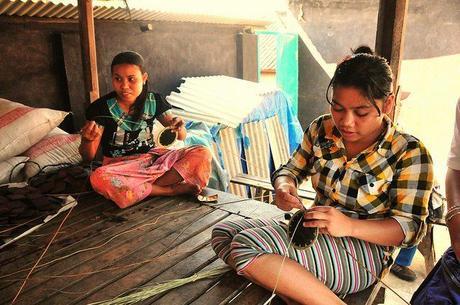by Sara Palmer / Climate-Connections

Indigenous women from the Indonesian island of Lombok make traditional handicrafts using supplies from the forest. Photo: Amantha Perera/IPS
Indonesian women from the Mollo territory are known for weaving beautiful, intricate fabrics from dye they harvest in the surrounding forests. When mining corporations barged in and began ravaging the land for marble, the women refused to sit idly by as these companies ripped out forests, dumped tons of toxins into their rivers and mutilated the iconic Mutis Mountains.
I felt they were raping my land, I could not just stand aside and watch that happen, said Indonesian environmental activist Mama Aleta in the article Women Warriors take Environmental Protection into their own Hands. We wanted to tell the companies that what they were doing was like taking our clothes off, they were making the forest naked by [cutting down] its trees.
Mama Aleta and several other women walked from village to village, explaining the situation to others in the Mollo territory, inspiring them and encouraging them to take a stand. Nearly 150 of them united, sitting and weaving in front of the mines in silent protest. The companies lasted another year before they were forced to abandon their four mines in the area.
Nearly 3000 miles away, in the eastern Indian state of Jharkhand, another group of women rallied to protect their forests from commercial timber plantations. In the same article, reporter Amantha Perera writes:
The women then went to the local police station – accompanied by children, men and elders from the village – and began to pluck and eat the fruit from guava trees in the compound, announcing to the officers on duty that they wanted only trees that could provide for the villagers.
On another occasion, when police showed up to arrest women leaders in the community, including Bhagat, they announced they would go voluntarily – provided the police also arrested their children and livestock, who needed the women to care for them. Once again, the police retreated.
Now the women patrol the forest, ensuring that no one cuts more wood than is deemed necessary.
Bhagat believes that her gender works to her advantage in this rural community in Jharkhand’s Ranchi district.
“If I were a man, I would have been arrested and thrown in jail by now,” she told IPS. “Because we women stand together, police are reluctant to act like that.”
So why are these “Women Warriors” so profound, so necessary in the fight against climate change? The answer could fill a thousand pages, but, in short, women are an “extremely vulnerable” population in the fallout of climate change. The burden of climate change falls heavily on these women, who play vital roles in the survival of their communities, families, farms, livestock and culture. In addition, women’s roles have historically been undervalued, so by protecting their environments, they are harnessing their collective voices to make an impact on a global scale.

